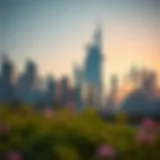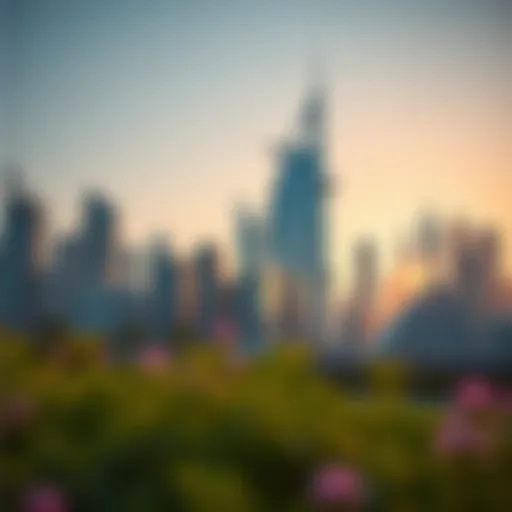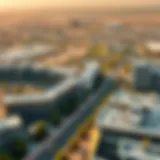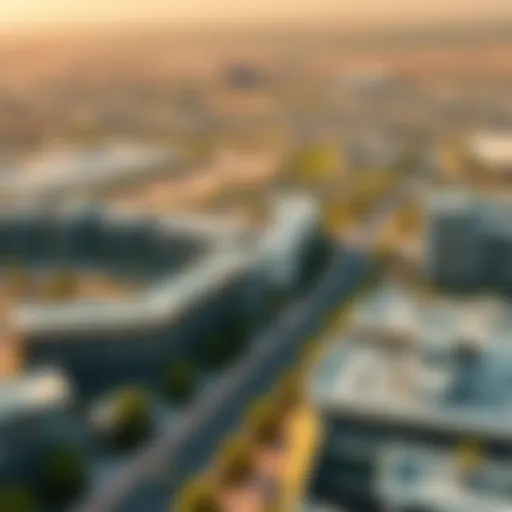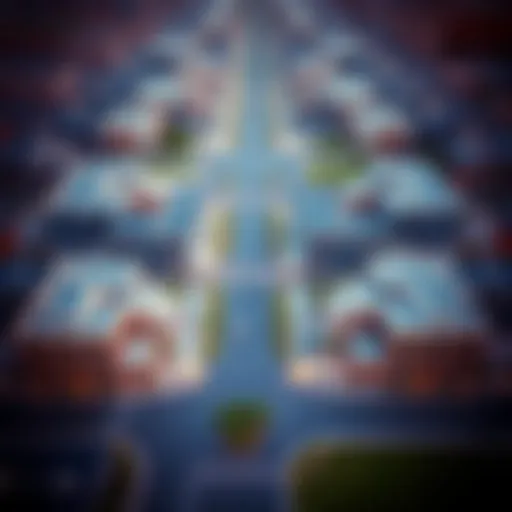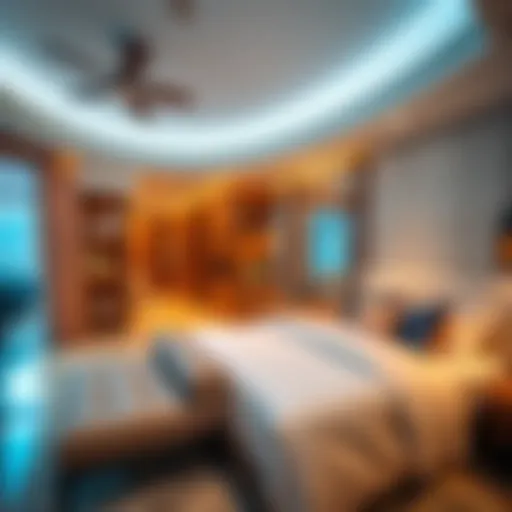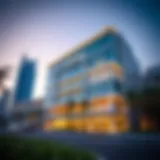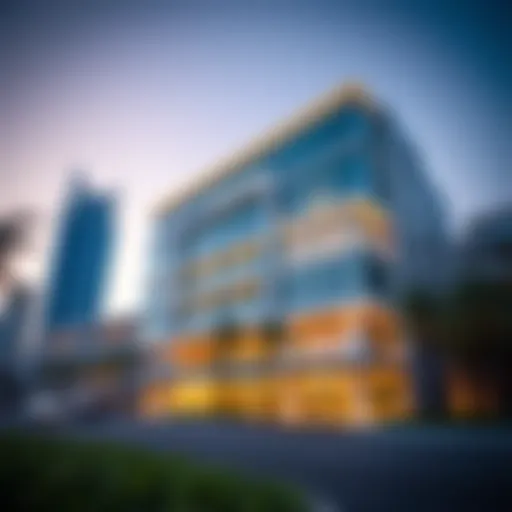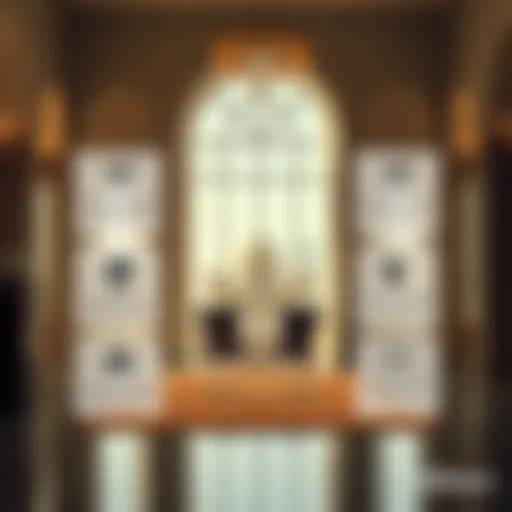Explore Dubai: Essential Tourist Attractions Guide
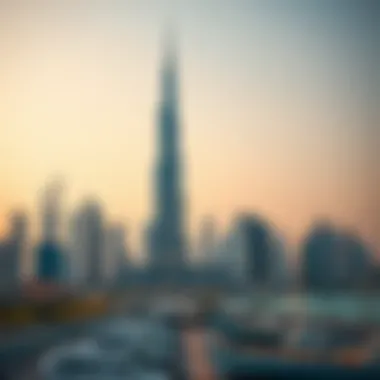
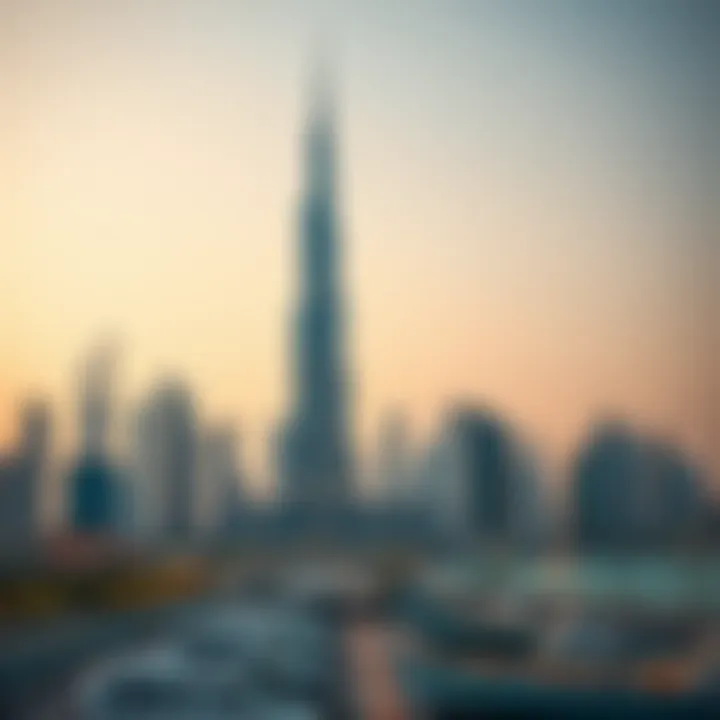
Intro
Dubai is often seen as a glittering oasis of modernity and tradition, where present-day achievements sit side by side with remnants of a rich cultural past. For tourists, it’s not just about shopping in extravagant malls or lounging on pristine beaches; it's an opportunity to experience the unique blend of art, history, and architectural wonders. This article presents a meticulous overview of the key attractions that make Dubai a premier destination for travelers. Whether you're dreaming of the sprawling museums or the thrill of adventure parks, there's something for everyone in this diverse city.
Dubai’s skyline is famously dotted with architectural marvels like the Burj Khalifa, the tallest building in the world, and the Burj Al Arab, a symbol of luxurious living. Beyond mere structures, these attractions tell the story of human ambition and ingenuity. Visitors also find enjoyment in the cultural gems such as the Dubai Museum and the historical Al Fahidi Neighborhood. There's no shortage of activities, be it camel riding through the desert on a golden dune or enjoying the mesmerizing Fountain Show at the base of the Burj Khalifa.
Moreover, this guide serves not only those planning to visit but also potential real estate investors seeking to unlock the mysteries of Dubai’s dynamic property market. By understanding the correlation between these attractions and the property trends, both buyers and investors can make informed decisions.
As we explore Dubai’s tourist attractions, we will delve deeper into their historical significance, the architectural features that make them stand out, and the overall experience they offer, ensuring a thorough grasp of what Dubai has in store.
Overview of Dubai as a Tourist Destination
Dubai is a hotspot when it comes to tourism. It’s not just about the glitz and glam, but there’s a whole history and culture underneath all that sparkle. For those looking at investment or even just a vacation, understanding what Dubai offers is crucial.
Historical Context
Dubai, which has transformed from a small fishing village in the 18th century to a global city, is a telling example of how rapid development can change a place's identity. Originally, it thrived on trade and pearl diving. The discovery of oil in the 20th century served as a springboard for its economic boom. The government invested heavily in infrastructure, education, and healthcare, leading to the city we see today—a blend of tradition and modernity.
As you walk through the narrow lanes of the Al Fahidi Historic District, one can almost hear the whispers of the past that echo off the walls of the old wind towers. These structures reflect a time when air conditioning was a luxury, and innovative designs were crucial in coping with the arid climate. The Dubai Museum located inside the Al Fahidi Fort offers a glimpse into this history. Besides, the importance of trade routes through the region during differing eras shapes current tourist offerings, making them rich with context and relevance.
Cultural Significance
Culture in Dubai is a melting pot, much like a good pot of stew. You have Emirati traditions mixed with influences from South Asia, the Middle East, and beyond. This diversity not only enriches the city but also draws many visitors. From the tantalizing aromas wafting from the spice souks to the vibrant colors of textile markets, every corner offers a slice of culture.
Visiting the Dubai Opera or attending a cultural festival provides insights into the artistic aspirations of its residents. The arts scene is blossoming, offering performances that range from local talent to international acts. Moreover, the Jumeirah Mosque welcomes visitors of all faiths, showcasing the openness of Emirati culture and the importance placed on dialogue and interaction among diverse communities.
In summary, understanding the historical and cultural context of Dubai enhances the overall travel experience. A proper grasp of its roots leads to deeper appreciation of its rapid growth, as well as the unique offerings that define its modern tourist attractions. Whether you’re a visitor exploring its landmarks or an investor looking to capitalize on its booming tourism sector, grasping Dubai’s background is undoubtedly beneficial.
Architectural Marvels
The architectural landscape of Dubai is a captivating blend of the contemporary and the traditional, making it one of the most photographed cities in the world. The towering skyscrapers and unique designs are not just feats of engineering; they portray the aspirations and innovations of a burgeoning metropolis. Dubai’s architectural marvels serve as symbols of its rapid growth and development, drawing millions of tourists each year. These structures often represent a city in transition, showcasing its history, culture, and vision for the future.
Burj Khalifa
Design and Engineering
The Burj Khalifa, standing as the tallest building in the world, is a prime example of cutting-edge design and engineering. The architects utilized a Y-shaped tripartite plan to maximize views and sustain wind loads, which is crucial for high-rise buildings. Its unique shape not only enhances stability but also contributes to its iconic silhouette against the Dubai skyline. This design choice has helped position the Burj Khalifa as a popular subject for architects and students alike, inspiring many discussions within the fields of architecture and engineering.
One remarkable aspect of its engineering is the use of reinforced concrete – a material that has offered both strength and flexibility. This has proven beneficial, especially in the face of environmental challenges, such as high winds. Moreover, from a practical perspective, its height has redefined land use in urban settings, driving demand for premium real estate nearby.
Visitor Experience
Visiting the Burj Khalifa is not merely about gazing at its towering height but immersing oneself in a unique experience from the ground to the observation decks. The journey begins with a high-speed elevator that whisks visitors to the 124th floor in under a minute. The view from the observation deck is breathtaking, offering panoramic sights of Dubai's vibrant contrasts, from its sandy beaches to sprawling urban landscapes.
What makes this experience particularly noteworthy is the meticulously designed visitor center that provides insights into the building's construction and Dubai's rapid development. However, the sheer popularity of the Burj Khalifa means long queues during peak seasons - something potential visitors must plan for. While this can create challenges, the overall experience remains one of awe, making it a must-visit destination.
Burj Al Arab
Iconic Status
The Burj Al Arab stands as a testament to luxury and opulence. Its sail-like shape has become synonymous with Dubai’s skyline. The building is not just an architectural gem but also an emblem of the city itself, often featured in promotional materials and tourism brochures. This iconic status significantly contributes to Dubai's brand as a luxury destination, reinforcing its image to both domestic and international audiences.
Moreover, the Burj Al Arab is often regarded as one of the most photographed hotels in the world. Travelers view it as more than just a place to stay; it symbolizes success and extravagance, attracting visitors eager to experience its majestic design. However, such a status comes with high operational costs, requiring constant maintenance to ensure it meets the luxury standards it represents.
Luxury Experience
Staying at the Burj Al Arab promises an unrivaled experience. With an interior that's adorned with gold leaf, spacious suites, and exceptional service, guests are treated to one of the most lavish accommodations on the planet. Notably, the private beach and multiple world-class restaurants add to the hotel's allure. Each aspect is meticulously curated to enhance the feeling of exclusivity.
However, this luxury experience comes at a high price point, making it less accessible to the average traveler. While some consider it a dream destination, the costs involved can exclude many from enjoying this exquisite experience. It raises questions about the future of luxury tourism in an increasingly competitive market, yet it remains a pinnacle of sophistication in Dubai.
Dubai Frame
Symbolism


The Dubai Frame serves as a literal and metaphorical bridge between the old and new Dubai. Positioned strategically in Zabeel Park, it distinctly separates the historical neighborhoods from the modern skyscrapers, reinforcing the narrative of progress. This symbolism captures the essence of Dubai’s journey, from its modest beginnings as a fishing village to becoming a global hub of business and tourism.
Its golden frame represents the strength of the region's cultural heritage while promoting a vision of the city’s bright future. This dual perspective appeals to both locals and tourists, making it a significant landmark for cultural discussions. However, some argue it might oversimplify the rich history of the area, reducing it to a visual motif rather than a comprehensive narrative.
Viewpoints
The viewing platform of the Dubai Frame offers stunning vistas that connect past and present. Visitors can catch glimpses of the historical sites in Old Dubai while also appreciating the architectural advancements of modern skyscrapers surrounding them. This contrast allows guests to reflect on the dramatic changes the city has undergone over the years.
Moreover, the platform itself is designed with clear glass floors, enhancing the sensation of floating above the city. However, this can be disconcerting for some, as not every visitor is comfortable with the height. Balancing excitement and unease is a unique feature of this attraction, which draws a diverse crowd eager to experience this architectural wonder.
Cultural Landmarks
Cultural landmarks serve as the heartbeat of any city, illuminating its past while celebrating its present. In Dubai, these sites are not just architectural wonders; they encapsulate stories of tradition, faith, and resilience. Tourists and locals alike are drawn to these genuine representations of the city’s rich heritage. They offer a gateway to understanding the diverse community that calls Dubai home, sparking curiosity and appreciation among those who visit.
Dubai Museum
The Dubai Museum, located within the historical Al Fahidi Fort, stands as a testament to the city’s transformation from a humble fishing village to a bustling metropolis.
Exhibitions and Artifacts
The exhibitions and artifacts housed in the Dubai Museum play a pivotal role in narrating the tale of Dubai’s evolution. The museum boasts a range of immersive displays, from ancient Arabic manuscripts to recreated traditional marketplaces. Each artifact provides a unique glimpse into the lives of the Emiratis in eras gone by. This vast collection, not only showcases the rich tapestry of local history but also draws considerable interest from history buffs wishing to delve deeper into Dubai's cultural roots.
The key characteristic of these exhibitions is their immersive quality. Visitors are led through carefully curated environments that recreate the past, making it a popular choice for tourists of all ages. However, one advantage to consider is the museum's accessibility; it offers audio guides in multiple languages, allowing a broader audience to engage without barriers.
Interestingly, while most museums opt for traditional display methods, the Dubai Museum integrates technology. Interactive stations enable visitors to engage more dynamically with the exhibits. This modern approach to storytelling can sometimes overshadow the quieter, historical artifacts, which some purists may feel are underappreciated.
Educational Value
The educational value of visiting the Dubai Museum cannot be overstated. Beyond just a historical showcase, it functions as a learning hub for all demographics. Organized workshops and guided tours facilitate an understanding of Emirati culture, heritage, and social structures, making it an excellent resource for students and families alike.
A key characteristic of this educational experience is its focus on inclusivity. The museum consistently strives to make information accessible across different learning styles, offering visual displays alongside interactive learning. This commitment to education is beneficial for teaching younger generations about their history and promoting an understanding of various cultural backgrounds.
However, a drawback to consider is the evolving scope of information presented. With Dubai's rapid growth, some critics argue that the museum can fall short in covering recent developments adequately. Nevertheless, it remains a cornerstone of cultural education in the UAE, actively bridging the gap across generations.
Jumeirah Mosque
Jumeirah Mosque, with its stunning white stone exterior and elegant design, illustrates Islamic architecture at its finest. This site not only serves as a place of worship but also as a symbol of cultural understanding for tourists.
Architectural Features
The architectural features of Jumeirah Mosque are a visual feast. Its intricate details, from the minarets to the domes, showcase the beauty of Islamic design. The mosque is one of only a few in the UAE that welcomes non-Muslims, which enhances its significance as a cultural landmark.
Highlighting the key characteristic of this mosque is its blend of traditional and modern architectural techniques. The limestone structure, adorned with intricate carvings, exemplifies a commitment to craftsmanship. This aspect makes it a beneficial choice for architecture enthusiasts and tourists who appreciate aesthetic beauty alongside cultural insights. However, while the mosque is visually stunning, one disadvantage could be that it operates mainly as a religious site; its busy prayer times may limit access for tourists seeking to take in its design intricacies.
Visitor Programs
Visitor programs at Jumeirah Mosque offer invaluable experiences aimed at promoting an understanding of Islam. Friendly guides often lead tours, sharing insights into the mosque's history, architectural elements, and Islamic practices.
A distinctive feature of these programs is the emphasis on dialogue and open conversation, fostering a space where people from all walks of life can engage respectfully about faith and culture. The programs are widely popular among those seeking to gain firsthand knowledge of a religion that often remains misunderstood.
Yet, while these programs educate many, they can pose challenges regarding timing and availability. Limited slots and specific schedules can sometimes leave visitors feeling rushed. Overall, Jumeirah Mosque stands as a pillar of intercultural exchange and is a must-visit for anyone looking to enhance their understanding of Dubai's diverse society.
Leisure and Entertainment Destinations
In Dubai, leisure and entertainment destinations play a vital role, knitting together the vibrant tapestry of experiences that the city offers. With the perfect blend of shopping, adventure, relaxation, and cultural engagement, these areas elevate Dubai from a mere tourist stop to a genuine playground where consumers and investors alike can thrive. The mix of attractions not only entertains visitors but also fosters economic growth through increased real estate demand and commercial investments.
Dubai Mall
Shopping Experience
Dubai Mall, one of the largest shopping complexes in the world, provides an unparalleled shopping experience that draws millions of visitors each year. It boasts over 1,200 retail outlets, making it a quintessential aspect of the city's consumer culture. Here, shoppers find everything from high-street brands to luxury goods. This diversity is a shining characteristic, allowing patrons to browse for that perfect item, whether they’re looking for the latest designer handbag or a unique local souvenir.
The mall’s layout encourages exploration. Lighting and design are thoughtfully crafted, creating an inviting atmosphere.
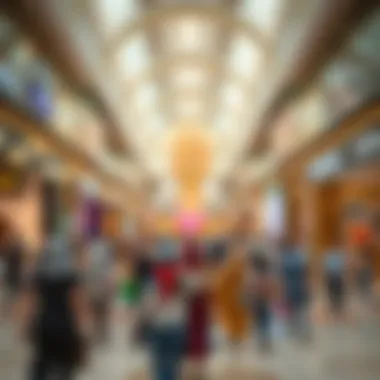
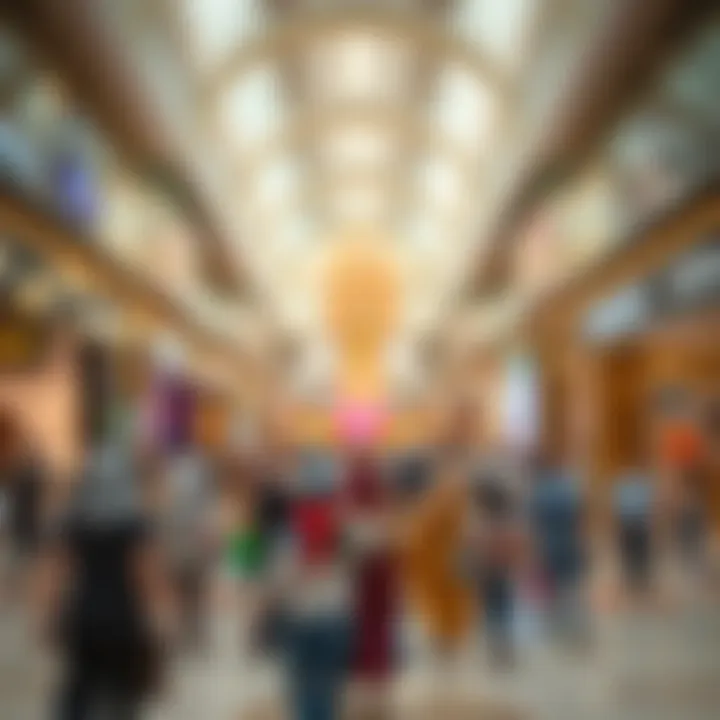
A standout feature is the ability to combine shopping with leisure. The Dubai Aquarium and Underwater Zoo, located within the mall, allows shoppers to pause their retail therapy and marvel at marine life, establishing a unique experience that few malls worldwide can offer. However, it’s worth noting that some visitors may feel overwhelmed by the crowds, especially during peak seasons, which could affect their overall enjoyment.
Entertainment Options
Beyond retail, Dubai Mall offers an array of entertainment options that enhance its appeal as a multifunctional venue. Visitors can catch a glimpse of the spectacular Dubai Fountain, which performs daily shows, creating a breathtaking experience against the backdrop of the Burj Khalifa. The time-honored tradition of watching the fountain dances is a hallmark of what makes this destination special.
Another major draw is the Vox Cinemas, where movie aficionados can enjoy the latest films in luxe comfort. With its IMAX and 4DX features, it transforms a simple movie night into an extraordinary experience. While these entertainment amenities are largely beneficial, they can lead to long wait times, especially on weekends and holidays.
Dubai Parks and Resorts
Diverse Attractions
Dubai Parks and Resorts encapsulate the thrill of multiple worlds in one destination. Covering a vast area, this entertainment complex includes Motiongate, Bollywood Parks, and Legoland, providing extensive choices that suit all ages. This diversity means that whether you’re a thrill-seeker looking for high-speed roller coasters or a family with young children, there's something for everyone.
The unique feature of Dubai Parks and Resorts is its ability to blend various entertainment formats into a cohesive experience. For instance, one can enjoy cinematic adventures in Motiongate while drifting into a Bollywood extravaganza next door. However, it is essential for visitors to meticulously plan their visits, as navigating between parks can be time-consuming and lead to potential fatigue.
Family-Friendly Environment
Being a family-friendly environment sets Dubai Parks and Resorts apart. It prioritizes safety and accessibility, ensuring that parents can enjoy their day without undue worry. The attractions are designed with families in mind, featuring kid-friendly rides, play areas, and family lounges, which makes it an endearing choice for those traveling with children.
Additionally, multiple dining options cater to various tastes and dietary needs, further enhancing the family-oriented experience. Still, peak times may see the parks crowded, which could detract from a family's ability to fully enjoy the attractions without long wait times.
"Dubai is not just a destination; it's an experience that unfolds in layers, especially through its leisure and entertainment sectors, which are pivotal for both visitors and real estate investors."
The array of leisure and entertainment destinations in Dubai not only accentuate its tourist appeal but also draw interest from investors and developers looking at potential real estate opportunities. With the right strategy, these attractions can yield substantial returns in a market that's consistently evolving.
For additional information about Dubai's attractions, visit:
Natural Attractions
Natural attractions are a vital piece of the puzzle when it comes to experiencing the allure of Dubai. These features not only showcase the stunning landscapes and unique ecosystems in the region but also provide a contrast to the city's modern architecture and vibrant human activities. The natural wonders of Dubai offer tourists a chance to connect with nature, indulge in thrilling activities, and enjoy some tranquil moments away from the city's hustle and bustle.
Desert Safaris
Desert safaris stand out as a thrilling facet of Dubai's natural attractions. They capture the adventurous spirit of both tourists and locals alike, offering a unique glimpse into the mesmerizing Arabian desert.
Adventure Activities
Desert safaris are loaded with adventure activities that can leave one's heart racing. From dune bashing in robust 4x4 vehicles to traditional camel rides, these pursuits offer visitors an exhilarating way to explore the sandy terrain.
A key characteristic that really sets the tone for these excursions is the adrenaline rush they provide. Imagine feeling the exhilarating propulsion of an SUV skipping across the dunes or swaying gently atop a camel, the gentle whispers of the wind guiding the way. This makes desert safaris a wonderful choice for anyone wanting an original experience. The thrill is palpable, and the excitement draws countless travelers each year.
However, in the midst of the joy and adventure, one must be mindful of safety and environmental impact. Going too fast over the dunes can be risky, and careless driving may harm delicate ecosystems.
Sustainability Concerns
Sustainability concerns have become critical in recent years, especially regarding desert safaris. The growth of adventure tourism puts pressure on the sensitive desert environment, raising questions about how to maintain balance.
One key factor here is minimizing ecological footprints. Tour operators increasingly engage in practices like utilizing eco-friendly vehicles or adhering to strict guidelines to protect wildlife. This transition highlights a shift towards responsibility, ensuring both tourists can have fun while preserving the breathtaking scenery of the desert for generations to come.
The unique feature of this focus on sustainability is its dual benefit. Not only does it safeguard habitats, but it also enhances the experience for visitors, who are increasingly inclined to engage in responsible tourism practices. It's a win-win situation, fostering a sustainable adventure while enjoying the thrill of the desert.
The Palm Jumeirah
The Palm Jumeirah is undoubtedly one of Dubai's most striking natural attractions. This man-made island is not only an engineering wonder but has also become a symbol of luxury and innovation.
Engineering Feat
What makes the Palm an engineering feat is its unique design and construction method. Built in the shape of a palm tree, it includes an outer crescent and 17 fronds, showcasing human ingenuity in land reclamation. More than a mere tourist spot, it illustrates the blend of technology and nature, creating an iconic landscape that attracts visitors from all over.
The wonderful aspect of the Palm's construction is its ability to withstand harsh coastal conditions, making it a resilient part of Dubai's infrastructure. Nevertheless, one must consider the environmental ramifications of such grand constructions; land reclamation has raised concerns among ecologists regarding its impact on marine ecosystems.
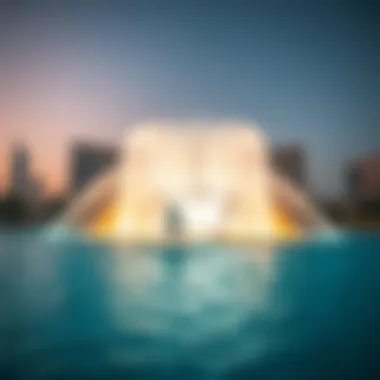
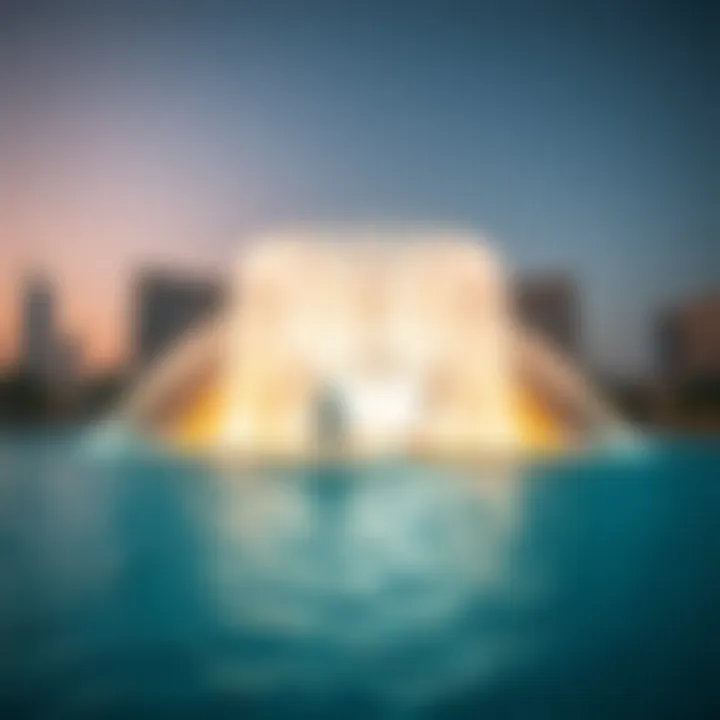
Recreational Opportunities
This grand island also opens up a world of recreational opportunities that cater to all. From pristine beaches to high-end resorts and waterparks, there’s no shortage of activities for visitors. Families can find themselves enjoying days full of fun, while couples can find romantic spots to relax and unwind.
The Palm's beach access and the thriving nightlife offer something for everyone, making it an essential part of any tourist’s Dubai itinerary. However, it’s important to note that such developments may come with elevated prices that could deter budget travelers. Despite this, the wealth of recreational options and the unique experiences available make the Palm Jumeirah stand out as an unforgettable destination.
While the Palm Jumeirah showcases human creativity, the commitment to sustainability will define its future resonance with both residents and visitors alike.
Emerging Attractions
In the rapidly evolving landscape of Dubai, emerging attractions hold significant importance, shaping the future of tourism and investment opportunities in the region. These sites often anchor new cultural experiences and developments, drawing travelers who seek the latest in entertainment and innovation. Highlighting these attractions allows investors and tourists alike to understand where the city is headed, the design of its future, and the increasing capabilities of its infrastructure.
Expo Site
Legacy and Impact
The Expo 2020 site symbolizes more than just a past event; it represents a long-lasting legacy that Dubai is keen on promoting. This grand exhibition showcased innovations from various countries, emphasizing sustainability, mobility, and opportunity. One of the key characteristics of this site is its commitment to fostering international collaboration, which resonates with Dubai's historical identity as a melting pot of cultures. The legacy left by this expo is not merely about architecture but also about the socio-economic developments it spurred. After the expo, the site transitions into a vibrant community hub, transforming into a residential and business center.
Unique features, such as the Sustainability Pavilion, highlight advancements in eco-friendly technologies. The advantage here is clear— these innovations position Dubai as a leader in global sustainability efforts. However, there are challenges associated with maintaining momentum and interest in the area once the initial buzz fades.
Future Developments
The future developments arising from the Expo 2020 site promise to expand the city’s appeal and its dynamic urban landscape. The final vision includes creating a multifunctional area with parks, museums, and commercial spaces. This vision shows a commitment to enhancing community engagement, making it a beacon of modernity and inclusivity.
The key characteristic of these developments is their focus on integrating cutting-edge technologies through smart city initiatives, which could be appealing to investors looking for forward-thinking opportunities. An exciting feature is the planned cultural districts, which aim to attract artists and innovators. However, potential downsides could involve the challenge of sustaining interest and investment long-term, especially in a market that is constantly searching for the next big thing.
Dubai Creek Tower
Construction and Vision
The Dubai Creek Tower stands as a testament to the ambitious spirit of Dubai. With its already remarkable design, once completed, it’s expected to eclipse other skyscrapers, offering stunning views and a unique visitor experience. The construction phase has been carefully executed, showcasing engineering prowess that enhances the tower’s iconic stature.
The vision underlying the tower focuses not just on height but on creating a location that exemplifies cultural resonance and accessibility. The unique feature of this attraction is the incorporation of traditional architectural elements into modern design, reflecting the city’s heritage. As a benefit, it promises to draw tourism and spur local business growth. Still, high construction costs and potential delays are factors investors should consider.
Potential Visitor Interest
With Dubai Creek Tower set to become one of the tallest structures in the world, potential visitor interest is expected to skyrocket. This interest stems from the tower's design, which creates a connection to local culture while showcasing modern engineering. It’s also a hotspot for those looking to experience breathtaking views of the city.
The key characteristic of this attraction is its 28 observation decks, providing a never-before-seen perspective on the area. This could make the tower a valuable addition to any tourist’s itinerary. However, visitors might face challenges such as high entrance fees or crowded peak times, which could differentiate their experience. Thus, for stakeholders, balancing accessibility with exclusivity will be crucial as the tower continues to unfold its potential.
"Emerging attractions in Dubai are not just about what is built; they define how the city grows in spirit and community over time."
In concluding this section on emerging attractions, it becomes evident how vital they are in the broader context of tourism and real estate investment in Dubai. By focusing on innovative developments such as the Expo 2020 site and the Dubai Creek Tower, stakeholders have a clear view of the potential that lies ahead in one of the world’s most exciting cities.
Implications for Real Estate
The rise of Dubai as a global tourism hub has a profound impact on its real estate landscape. This relationship between tourism and real estate is not merely a coincidence; rather, it manifests in numerous ways that hold significance for investors and homebuyers alike. The influx of international visitors fuels demand for various types of properties, ranging from luxury accommodation to retail spaces. Consequently, investors must understand how this dynamic can affect their decisions.
Tourism and Real Estate Correlation
The correlation between tourism and real estate in Dubai is unmistakable. First, increased tourist traffic typically leads to greater demand for short-term rental properties. Investors focusing on tourist hotspots can reap substantial rewards as vacationers seek comfortable and convenient places to stay. Additionally, high tourist footfall enhances local amenities, contributing to a more attractive living environment. This, in turn, attracts expats and long-term residents, creating a robust rental market.
The real estate sector in Dubai is also supported by government initiatives. Authorities are constantly enhancing infrastructure and accessibility, making it easier for visitors and residents to navigate the city. Major projects like the expansion of the Dubai Metro and new road networks contribute to fluid transport options. As transportation improves, the appeal of various neighborhoods grows, pushing property values upward.
Investment Opportunities
Residential Areas
Investing in residential areas of Dubai can be a profitable venture. Neighborhoods such as Dubai Marina and Downtown Dubai offer high rental yields due to their proximity to key attractions. These areas are also characterized by modern amenities, such as parks, shopping centers, and vibrant nightlife, which appeal to both residents and tourists. The unique feature of these residences is the blend of luxury and convenience, often featuring smart tech integrations that enhance living experiences.
However, let's not gloss over the challenges. Property prices in these sought-after locations can be steep, and competition in the rental market is intense. Therefore, potential investors must engage in diligent research and strategic planning to navigate this landscape effectively.
Commercial Developments
Commercial developments in Dubai play a pivotal role in the local economy, and investing in these can yield significant returns. Areas such as Business Bay and DIFC are bustling with activity, making them prime locations for retail and office spaces. The key characteristic of these commercial zones is their proximity to major business districts and tourist attractions, ensuring continual foot traffic and visibility.
Investors should consider the growing trend of mixed-use developments, which combine residential, retail, and office spaces. Such projects not only draw in a diverse range of tenants but also enhance community engagement. Yet, there are drawbacks, including fluctuating demand based on economic conditions. It’s crucial for investors to analyze market trends and opt for developments that align with future growth forecasts.
"In Dubai, real estate is both a sanctuary for homeowners and a beacon for investors, illustrating the deep intertwining of tourism and property vitality."
Ultimately, the real estate implications of the tourism industry in Dubai are vast. For those in the market, understanding these trends is essential to making informed and impactful investment decisions. The continuous evolution of attractions and infrastructure will keep shaping opportunities for success in this dynamic property landscape.


